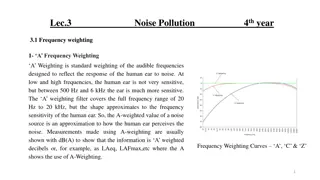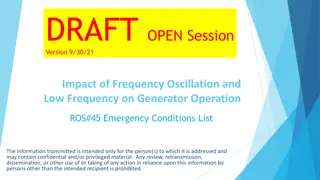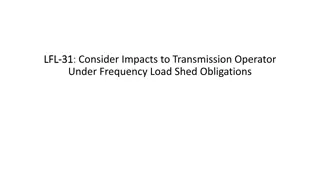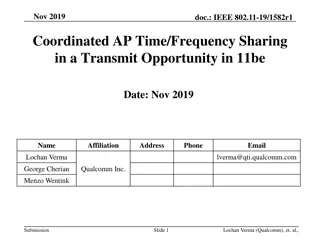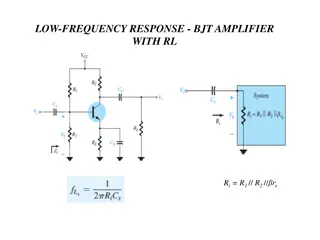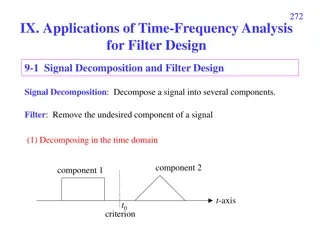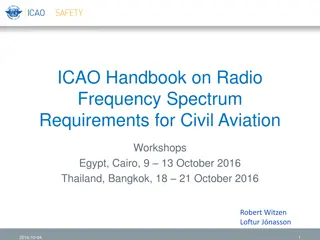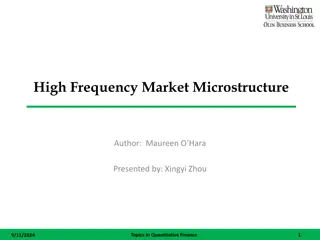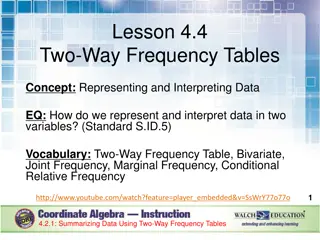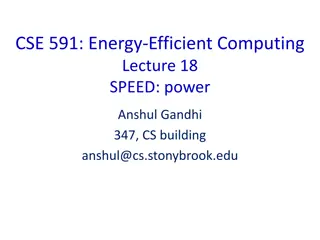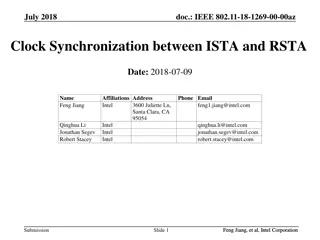
Understanding Frequency Capping in Online Advertising
Explore the concept of frequency capping in online advertising and its importance in sponsored search advertising. Learn about competitive ratio models, ad auctions, and our new frequency capping model to maximize gain and targeting efficiency.
Uploaded on | 0 Views
Download Presentation

Please find below an Image/Link to download the presentation.
The content on the website is provided AS IS for your information and personal use only. It may not be sold, licensed, or shared on other websites without obtaining consent from the author. Download presentation by click this link. If you encounter any issues during the download, it is possible that the publisher has removed the file from their server.
E N D
Presentation Transcript
Frequency Capping in Online Advertising Moran Feldman Technion Joint work with: Niv Buchbinder, Arpita Ghosh, Joseph (Seffi) Naor, The Open University of Israel Yahoo! Research Technion
Outline Motivations Competitive Ratio Models Previous models Our new model Our Results Reduction to unit frequency caps The equal values case The general case Open Problems 2
Frequency Capping in Online Advertising Sponsored search advertising Types of online advertising: Display advertising Different business models: Pay-Per- Click Pay-Per- Impression Frequency Capping Good Targeting Requires: 3
Competitive Ratio Standard performance measure for online algorithms. Notation I An instance of an online problem. ALG(I) The value of an online algorithm ALG on I. OPT(I) The value of the optimal offline algorithm on I. For Deterministic Algorithms For Randomized Algorithms ( ) ( ) I ( ) ( ) I OPT I OPT I sup sup ALG E ALG I I Against oblivious adversary. Other adversary types also exist. Randomization often improves the achievable competitive ratio. 4
Ad-Auctions Model Instance n advertisers: budget (di) bid for each keyword (bi,k) these parameters are known in advance. Impressions: Arrive online. Each one is associated with a keyword. Must be immediately assigned upon arrival. The gain is min{bid, remaining budget}. Objective Maximize the total gain. Known Result A tight 1 1/e competitive algorithm by Mehta et al. (2007) for large budgets. 5
Extended Model bi,k Difference (from previous model) The bid bi,k of advertiser i on keyword k: was a constant in the old model. is a non-increasing function of the number of impressions of keyword k bought by advertiser i so far. 3 2 1 1 2 Bid for first impression: 3 Bid for second impression: 2 Bid for next impressions: 0 6 Known Results An upper bound of 1 1/e follows from the result of the previous model. A 1 1/e competitive algorithm by Goel and Mehta (2007) for large budgets.
Our Frequency Capping Model Instance n advertisers demand (di). value per impression (vi). frequency cap per user (fi). the parameter are known in advance. Impressions: Arrive online. Each one is associated with a user. Must be immediately assigned. The gain is the value of the advertiser receiving the impression. Objective Maximize the total gain. 7
Inherited Result The frequency capping model can be represented as a special case of the extended model: Keyword = User. Bid is a step function dropping at the frequency cap. The 1 1/e competitive algorithm of Goel and Mehta (2007) applies to our model for large demands. The upper bound of the previous model does not necessarily propagates to the freq. capping model: Allowing different bids for different keywords/users create a matching aspect. The freq. capping model allows a single value for each advertiser. Strongest upper bound known for the freq. capping model is 0.707 > 1 1/e (for deterministic algorithms). 8
Our Results A reduction to the case of unit freq. caps. The other results are based on this reduction. A greedy -competitive algorithms for two cases: All advertisers have equal values. All advertisers have equal di/fi. A matching upper bound for deterministic algorithms. For the general case: An upper bound of 0.707. A different 1 1/e competitive algorithm for large demands: Based on the primal-dual method of Buchbinder and Naor (2009). Both increases and decreases primal variables. 9
The Reduction Allows to assume fi= 1 for all advertisers. Description Divide advertiser i to fi advertisers with demand of di/fi and di/fi , and frequency cap of 1. f=1 f=1 f =1 fi = 3 All impressions assigned by the algorithm to a new advertiser resulting from advertiser iis assigned in reality to advertiser i. Note that both demand and frequency capping constraints of original advertiser are always respected. 10
The Reduction (cont.) Lemma The reduction preserves the value of OPT. Proof Consider a single advertiser a split by the reduction to advertisers a1,a2, ,ak. Assume a1,a2, ,akare sorted in non- increasing demand order. Let OPTa be the set of impressions assigned by OPT to a. Order OPTa in such a way that all impressions of the same user are consecutive. Assign the impressions of OPTa to a1,a2, ,ak in a cyclic fashion. Demand and freq. capping constraints of the new advertisers are respected. a a1 a2 a3 11
Identical Values Case Upper bound (of ) Works even for unit frequency caps and equal demands. Two advertisers a1 and a2 with demand 2 and unit frequency cap. a1 a2 Three impressions of three different users arrive. There must be an advertiser assigned a single impression of some user. Next, another impression of this user arrives. 12
Result for Identity Freq. Caps and Equal Demands Theorem Consider advertisers of with unit frequency caps and equal values and demands. Any non-lazy algorithm is -competitive. Proof idea Our Maximal Loss Pay d/y* Full advertisers Pay y*/(d-y*) Minimal impressions per advertiser Our Maximal Loss * y d y Each impression of OPT-ALG gets: + 3 * * y d 13
Result for Identical Values Algorithm (3/4-competitive) 1. Sort the advertisers by demand. 2. Assign each impression to the first eligible advertiser. Reduction We can assume every advertiser is assigned by OPT more than by the algorithm. Proof idea Use flow arguments. 14
Result for Identical Values (cont.) Notation OPTj( ) Number of impressions assigned by OPT to ai. yj Number of impressions assigned by the algorithm to ai. kj An indicator whether the algorithm exhausts the demand of ai. B The impressions OPT assigned with no corresponding impression assigned by the algorithm. Analysis Idea Impressions of B assigned to advertiser ai get paid from two sources: Impressions of ai pay them yi/(di-yi). Impressions of full advertisers pay them di/yi. 15
Result for Identical Values (cont.) Difficulty We got the same payments as before. The difficulty is showing that the full advertisers can bear the cost. Theorem For every advertiser ai which is not full: i i ( ) = j = j OPT y y k j j i i 1 1 Implication Ties the number of B packets up to advertiser ai with the number of full advertisers to the left of ai. Advertisers to the left of aihave demand di. Used to show that the full advertisers have enough revenue to invest in their payments. 16
General Case Upper bound (of 0.707) Two advertisers with unit frequency caps: a1 demand 2 and value 1. a2 demand 1 and value 20.5. One impression of arrives. Case 1 Case 2 The configuration after the arrival: The configuration after the arrival: a1 a2 a1 a2 Two impressions of a new user arrive. Competitive ratio: No other impressions arrive. Competitive ratio: + 1 2 1 = 1 2 + 2 2 2 17
General Case (cont.) Dual Linear Program K ( ) j K ( ) B j max , , v y i j k i = 1 a A k i ( ) j ( ) K . t . s , , y i j k d a A i i = 1 j B k ( ) j ( ( ) ) = k , , , y i j k f a A j B i i 1 , 2 , 1 ( ) j y , , 1 , , y i j k j B k K a A ( ) i , , 0 i j k A The set of advertisers. B The set of users. K(j) The number of impressions of user j. y(i, j, k) Indicates advertiser ai got the kth impression of user j. 18
General Case (cont.) Primal Linear Program ( ) ( ) ( ) ( , , z w x Algorithm Upon arrival of impression k of user j: 1. Assign impression k to advertiser m1. 2. For each advertiser , set: w(i, j) max{0, (vi x(i)) (vm2 x(m2))}. 3. For each advertiser i S(j) m1, set: w(i, j) 0. 4. For each impression r k of user j, set: z(j, r) vm2 x(m2). 5. For advertiser m1, x(m1) x(m1) (1 1/di) + vm1 /(cd1) ( ) j K ( ) ( ) x A a i B j + + min , , d x i f w i j z j k i i j = 1 a A B k ) ( ) j i + + . t . s , , , , i w i j z j k d a A j B k K i i 0 ( ) j i S m 1 S(j) The set of advertisers not yet assigned an impression of j. m1, m2 the two advertisers maximizing vi x(i). 19
General Case (cont.) Remarks The constant c is (1 + 1/dmin)dmin - 1, where dmin is the minimal demand. Competitive ratio, 1 1 / (c + 1), which approaches 1 1 / e for large demands. The algorithm both increases and decreases primal variables. This is unlike other online primal-dual algorithms. The algorithm can be easily made to work with user targeting. In this case its competitive ratio is tight. 20
Open Problems Improving upon the 1-1/e competitive algorithm for general values and demands. The worst upper bound known is 0.707. Supporting targeting constraints regarding both: User Context (webpage) Improved approximation ratio for equal values and high demands. is known to be tight for low demands only. If all demands are equal and approach infinity, we have a 0.828-competitive algorithm. Using randomization to bypass the deterministic upper bounds. 21

